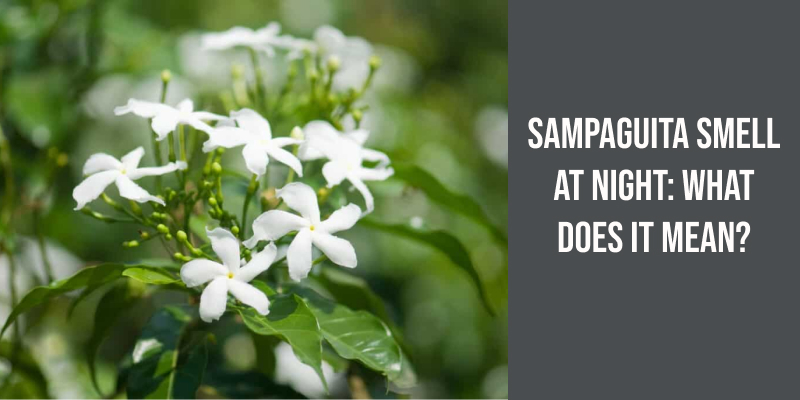The smell of Sampaguita at night is known for its strong and sweet fragrance. Sampaguita, also known as jasmine, is a type of flower that emits a more intense scent during the evening. This is because the fragrance attracts moths that pollinate the flowers. The scent is not only strong, but also distinctive, often described as a combination of deep floral notes with hints of green leaves, fresh and cool breeze. This is why the scent of Sampaguita is used for creating perfume and for aromatherapy purposes as well. The smell at night could also symbolize purity and is considered as a sign of respect and reverence in some Asian cultures.

What Does Sampaguita Smell Like?
Sampaguita, also known as Jasminum sambac or Arabian jasmine, is a small, white, highly fragrant flower native to Southeast Asia.
The scent of sampaguita is sweet, rich, and intoxicating. Its fragrance is often described as having a heady, floral, and slightly fruity aroma with notes of jasmine and honeysuckle. The scent is powerful and can be both calming and uplifting, making it a popular choice for perfumes and essential oils.
In many cultures, sampaguita is associated with purity, love, and romance, and it holds significant cultural and symbolic value. Its delightful fragrance has made it a sought-after flower in the perfume industry and a beloved scent in various floral arrangements and fragrances. The aroma of sampaguita is cherished for its ability to evoke feelings of beauty, serenity, and joy.
Despite the fact that Sampaguita is a perennial plant, it’s an extremely sensitive flower that needs proper care and attention. The process of cultivation is also a skillful and intricate process that’s done by local farmers who’ve a deep understanding of the flowers needs. These flowers need a combination of sunlight, good soil, and regular watering to ensure their survival. Without proper care, these flowers can easily wilt and lose their fragrance, making them unsuitable for use in any type of ceremony or event.
The fragrance is often mixed with other exotic scents and oils to create something that’s both beautiful and fresh.
If you’re familiar with the scent of sampaguita, you might be surprised to learn that another flower shares a similar fragrance. Tuberose, also known as the night-blooming flower, is a fragrant plant that produces a sweet, floral scent that’s often compared to sampaguita. In fact, the two flowers are often used interchangeably in perfumes and other scented products, thanks to their similar fragrance profiles. But what exactly is tuberose, and how does it compare to sampaguita? Let’s take a closer look.
What Smells Like Sampaguita?
Tuberose, also known as Polianthes tuberosa, is a flower that’s famous for it’s strong and captivating fragrance. This sweet and spicy smell has made it popular in the world of perfumery and aromatherapy. However, one of the most interesting things about Tuberose is that it’s a scent that closely resembles that of Sampaguita, a flower native to Southeast Asia.
Sampaguita, which is known by it’s scientific name Jasminum sambac, is a popular and iconic flower in the Philippines. It’s often used in traditional Filipino rituals and as a symbol of love and purity. It’s fragrance is described as sweet, heady and floral, somewhat similar to Tuberose. The scent of Sampaguita is so beloved that it’s been used as an inspiration for many perfumes and scented products.
Tuberose is a native of Mexico and Central America, while Sampaguita is found in tropical countries such as India, the Philippines, and Indonesia. The flowers of Tuberose are larger and more upright than those of Sampaguita, which are smaller and grow in clusters. Additionally, the colors of the two flowers differ, with Tuberose being predominantly white and Sampaguita having white or yellow petals.
Both Tuberose and Sampaguita are known for their evening blooming habits. Tuberose blooms during the summer months, with it’s white flowers carrying a sweet and rich scent that’s best experienced after nightfall. Sampaguita also blooms mainly at night and is often used in traditional Filipino garlands known as “sampaguita lei.”. Both Tuberose and Sampaguita have a heady, intoxicating fragrance, with their scents being potent enough to fill a room.
In many cultures, both Tuberose and Sampaguita are seen as symbols of love and sensuality. They’re often used in weddings and romantic occasions and are believed to carry lucky charms.
Both are beautiful flowers known for their intoxicating fragrance and are popular in the world of perfumes and aromatherapy.
Differences in the Medicinal Properties of Tuberose and Sampaguita and Their Uses in Traditional Medicine
- Tuberose is widely used in traditional medicine for treating respiratory problems, like asthma, bronchitis, and cough.
- Sampaguita, on the other hand, is known for it’s healing properties for skin-related problems, such as wounds, rashes, and insect bites.
- Tuberose is also said to be effective in relieving stress and anxiety, while Sampaguita is used to treat headaches and dizziness.
- Both flowers have anti-inflammatory and analgesic properties, which makes them effective in reducing pain and inflammation in the body.
- Tuberose is also believed to have aphrodisiac properties, which has made it a popular ingredient in traditional medicines and perfumes.
- Sampaguita, on the other hand, is believed to have a calming effect on the mind and body, which is why it’s often used in aromatherapy to relieve stress and promote relaxation.
Now that we know that sampaguita is a species of jasmine, it’s important to understand the cultural significance and popularity of both these plants.
Is Jasmine and Sampaguita the Same?
It’s native to Southeast Asia and is especially popular in the Philippines, where it’s the national flower. Sampaguita flowers are small and white, with a sweet fragrance that’s often used in perfumes and soaps. The plant has long been associated with love and romance, and is often given as a gift to symbolize these sentiments.
Jasmine, on the other hand, is a broader category of plants that includes many different species. While sampaguita is considered a type of jasmine, there are many other varieties with different shapes, sizes, and scents. For example, Arabian jasmine has larger, more heavily scented flowers, while Chinese jasmine has smaller flowers and a more subtle fragrance.
Despite these differences, all jasmines share certain characteristics, such as their cascading growth pattern and their tendency to bloom in warm, humid climates. They also have a rich cultural history, with jasmine being valued in many different cultures for it’s beauty and scent. In India, for example, jasmine is used to adorn temples and honor deities, while in parts of the Middle East and North Africa, it’s used to make tea.
In terms of cultivation, jasmine and sampaguita require similar care, both preferring moist, well-drained soil and plenty of sunlight. They can be grown in containers or as part of a garden, and can be trained to grow up trellises or walls. Because they’re tropical plants, both jasmines and sampaguita are sensitive to frost and should be brought indoors or covered during cold snaps.
Whether you prefer the delicate blooms of Sampaguita or the heady scent of Arabian jasmine, there’s no denying the allure of these stunning plants.
Differences in the Cultural Significance and Uses of Jasmine and Sampaguita in Different Regions and Traditions Around the World.
- Jasmine is commonly used in Chinese, Indian, and Middle Eastern cultures for it’s relaxing aroma.
- In Thailand, jasmine is also used in religious ceremonies and to honor the dead.
- Sampaguita, on the other hand, is the national flower of the Philippines and is often used in garlands for special occasions.
- In Filipino culture, sampaguita symbolizes purity and innocence.
- Both jasmine and sampaguita have been used in traditional medicine for their healing properties.
The significance of a name can never be underestimated, especially when it comes to celebrating one’s cultural roots. In Filipino culture, names carry deep meaning and are often chosen with great care. One such name that embodies loyalty and honesty is Sampaguita. This feminine name may be the perfect choice for parents who wish to honor their Filipino heritage and instill these values in their child’s identity. Let’s dive deeper into the meaning and significance of the name Sampaguita.
What Is the Meaning of Sampaguita?
Sampaguita is a very popular name in the Philippines and carries significant meaning for the Filipino people. This name is often given to young girls as a symbol of hope, promise, and loyalty. The name essentially represents the virtues that the Filipinos hold dear, namely trustworthiness and faithfulness.
The flower is known for it’s sweet fragrance and is often used in religious ceremonies and traditions. It’s also the national flower of the Philippines and represents the unity and resilience of the Filipino people in times of adversity. In fact, the Sampaguita flower is so valued that it’s often woven into garlands and wreaths as a symbol of hospitality and welcome.
It represents the countrys rich cultural heritage and the values that the Filipino people hold dear. It’s a name that celebrates family, tradition, and the promise of a bright future.
The Significance of Sampaguita in Philippine Culture
- Sampaguita is the national flower of the Philippines.
- It’s commonly used in many Filipino traditions and celebrations such as weddings, funerals, and religious ceremonies.
- Sampaguita is also known for it’s sweet fragrance and is often used to make perfumes, soaps, and candles.
- Aside from it’s beauty and fragrance, sampaguita also has medicinal properties and is used in traditional medicine for various conditions like fever, headache, and skin irritations.
- The sampaguita flower has also inspired many works of art, literature, and music in Philippine culture.
- Because of it’s significance, sampaguita has become an important symbol of Filipino identity and culture.
Conclusion
It’s intoxicating scent serves as a reminder of the beauty and simplicity of life, and it’s significance lies in the memories and emotions it evokes. It’s fragrance isn’t only a pleasing aroma but a reflection of the profound connections that exist between people, nature, and the culture that ties them together.





